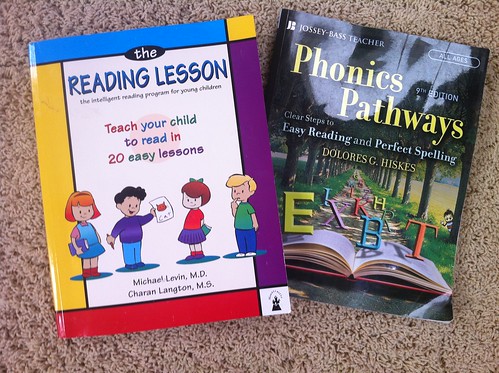I’m working on phonics with my third child. I know that doesn’t make me a pro, by any means, but I do feel like I’ve been around this bush before. I have purchased so many phonics programs, that it’s ridiculous. Let’s see, right off, I can think of: Writing Road to Reading, The Reading Lesson, Phonics Pathways, Explode the Code, First Language Lessons for a Well-Trained Mind, and Teach Your Child to Read in 100 Easy Lessons and that doesn’t count a couple of game based programs that I have.
If you are aghast that I purchased so many programs, don’t worry, I am too. (And my husband is going to learn from my blog post how many I’ve purchased, so I’ll have a little explaining to do.) The only thing I can say to defend myself is that I actually did try every single one. If you’re wondering how in the world I managed to try that many programs on so few children, I don’t know. One of my children was slow about learning to read, so I had the chance to try out a bunch of stuff on that one, I guess.
So are you curious which program I chose to use this round? I chose The Reading Lesson, which, believe it or not, is the very first program that I purchased. Sigh. I waisted a bunch of money.
Here is my short list of reasons why I returned to The Reading Lesson.
- It’s simple.
It doesn’t incorporate classical education or writing or even spelling. It’s just phonics. But neither does it have pages and pages of instructions for the teacher. It’s just simple and self-explanatory.
- It has simple illustrations.
I found that some of the others that I tried had no illustrations (Writing Road to Reading and First Language Lessons) and that my kids actually are more engaged with simple illustrations. I also found that the illustrations in Explode the Code were distracting for my kids. It seems that The Reading Lesson has found a nice balance between no illustrations and wild and crazy illustrations.
- It has simple stories starting in the second lesson.
This has turned out to be the biggest factor in my choosing this program. I’m fine with the stories and my kids are happy with the stories. Teach Your Child to Read in 100 Easy Lessons had too goofy of stories for me. Writing Road to Reading had no stories. First Language Lessons had stories that bored my kids. They always complained about the stories. Phonics Pathways had too few stories. They were always complaining that they wanted to read something real, not just a bunch of words. I realize I can use readers for stories, and we do use readers. We have Dick and Jane stories and we have easy Bible story readers and more. But having a simple story in the phonics program helps my kids want to not just use readers, but use the phonics program too. If it works and my kids are happy at the same time, then I’m happy too!
I have learned a little bit from teaching reading to my older two. One is that all the programs are almost alike. There are slight variations which the authors tout as making theirs far superior to the others, but they are basically alike. For a child who is ready to learn to read, any program will work. The ones written by people with their Ph.D. and the ones written by homeschool moms who have had three dozen children will all work, if your child is ready. Nonetheless, I think I’ve found my favorite, and beings that I have one to teach reading to now and a preschooler that will need to learn reading in a few years, I’m happy to have one program and stay with it and not try out anymore.

Nice to know I’m not the only one who has bounced from one phonics program to another! I’m on the third boy and am returning to my first program that I had ditched too. Ironically, I had decided on the Reading Lesson with my first, then rejected it, thinking he needed songs, etc. Now I’d just like simple and straightforward without all of the silly things to try to teach them!
:-)